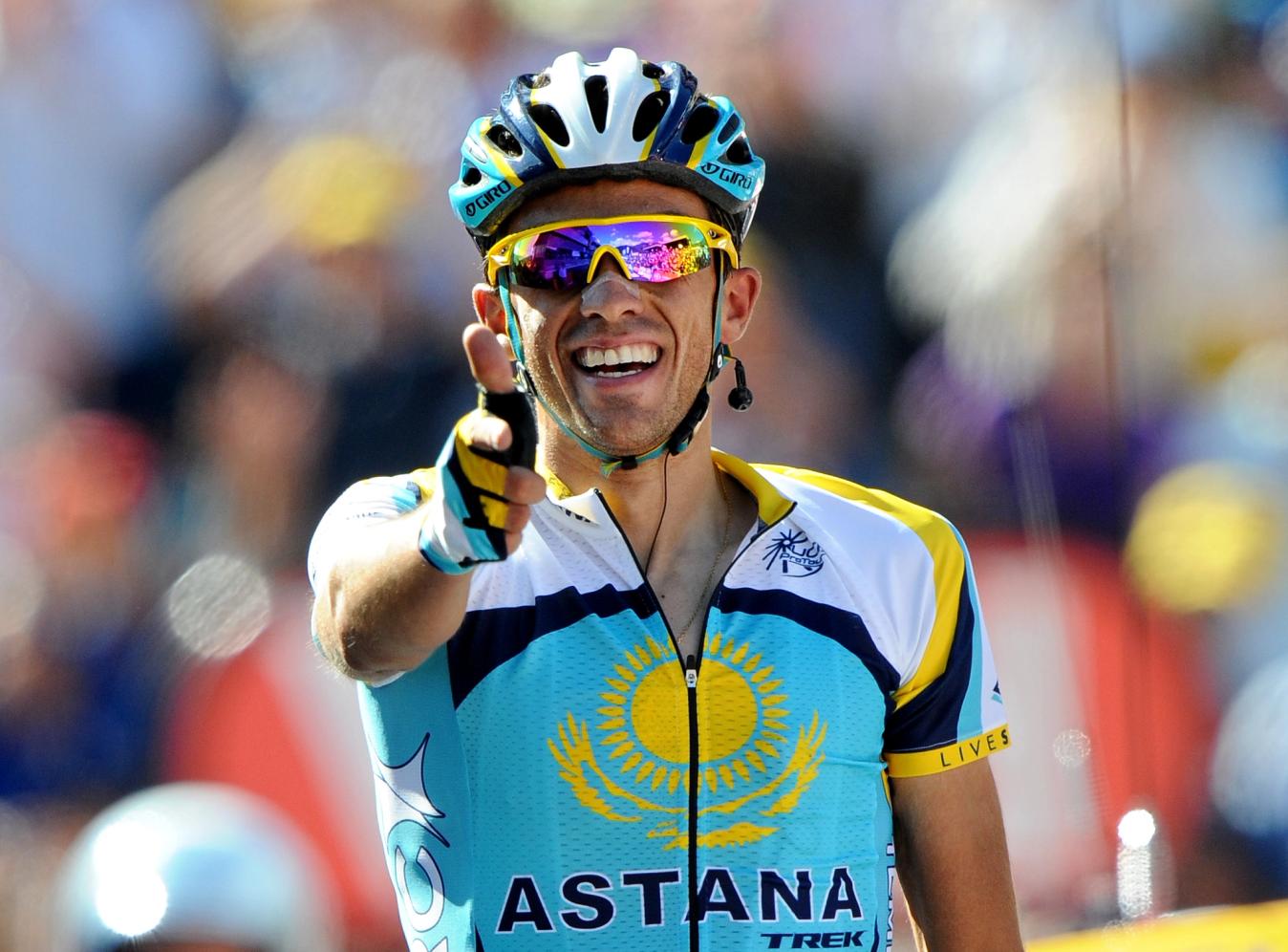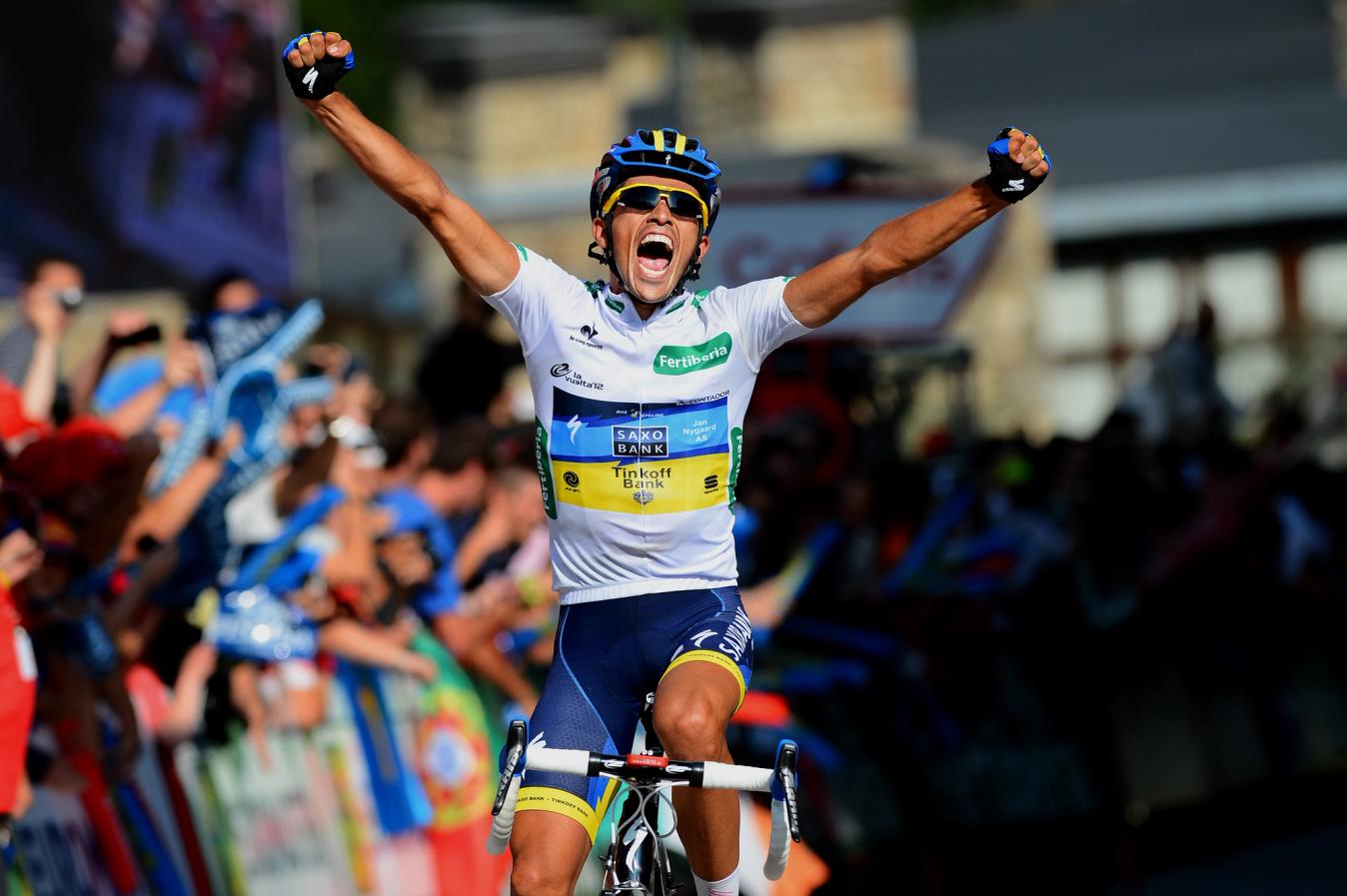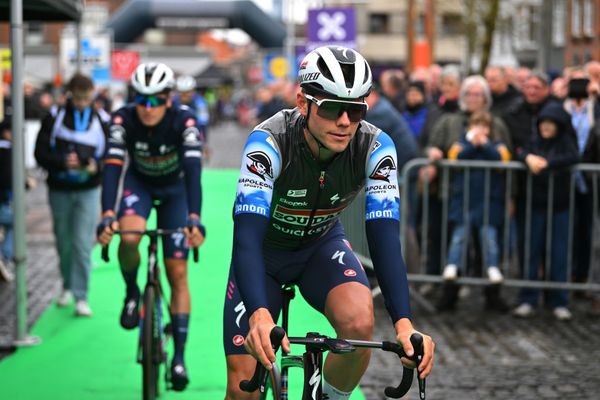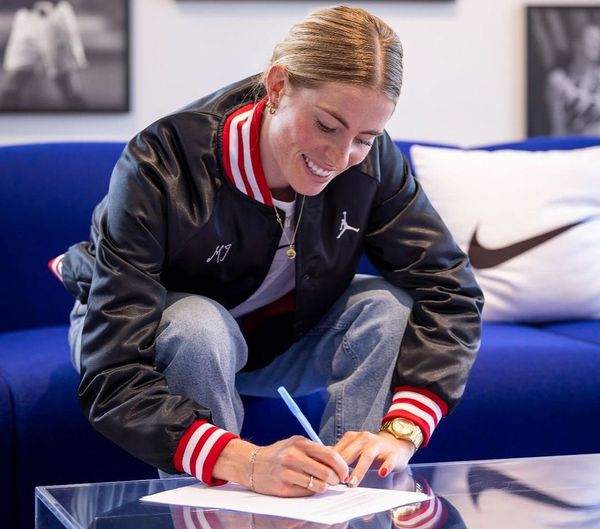The stages that made Alberto Contador legendary
And the three iconic shots from ‘El Pistolero’ which are included in this in-depth GCN+ documentary
Logan Jones-Wilkins
Junior Writer - North America
Alberto Contador does not retire like everyone else. Predictably, ‘El Pistolero’ attacked it.
Most cycling fans will know Alberto Contador for his staccato climbing style and audacious attacks that made him one of only seven riders to have won all three Grand Tours - the Giro d'Italia, Vuelta a España, and the Tour de France – but his career was more than just that glittering CV. During his 15-year career at the top, he suffered with a near-fatal brain condition, battled with bitter rivals like Andy Schleck, Chris Froome and Lance Armstrong, and found himself embroiled in scandal and controversy.
Watch: Rivals: Schleck vs Contador
GCN’s Bernie Eisel went to see Contador in his hometown of Pinto, Spain, to discuss his racing career, retirement and the complications that came from a doping suspension at the peak of his powers. Through the documentary, Contador’s evergreen cheer and persistent youth shone through as he talked through his past and present endeavours and challenges. There is ambition and audacity to almost everything he does, whether that is riding the Mortirolo or in starting a bike brand that would start a Grand Tour a year after its conception.
Through all of those ups and downs, that ambition that fuels El Pistolero has always helped Contador entertain. Throughout his career there are days where that entertaining, vivacious quality stands tall. Putting aside the controversy, his most ambitious exploits are some of the most memorable of the past two decades. Of all of the moments, here are three of his most audacious raids from each of the Grand Tours that distinguished his career.
Head over to GCN+ to watch the full film about Alberto Contador's career.
2009 Tour de France – stage 15 to Verbier

© Velo Collection (TDW) / Getty Images
Alberto Contador celebrates with his signature salute
The headlines going into the 2009 Tour de France were unlike any other in recent memory. Not only was the race the return of former seven-time champion Lance Armstrong, but also the return of his team, Astana, which was returning from a year hiatus from the Tour following a slew of doping positives and rider expulsions at the 2007 race. Furthermore, Astana added the defending champion, Contador, to their roster at the start of 2008 and he was coming back to the Tour with ambition to continue his Grand Tour winning streak.
It was a ding dong that was reminiscent of the young versus the old rivalry between Greg LeMond and Bernard Hinaut on La Vie Claire in 1986. If the media shadow boxing between Armstrong and Contador – in lieu of any racing confrontation – was anything to go from, it would be unlike any rivalry in the Tour in decades.
From a racing perspective, however, Armstrong was posturing on legacy more than form. The beginning of 2009 was only further confirmation of Contador’s stage race supremacy, with wins at the Volta ao Algarve and the Vuelta al País Vasco. His only real blip competitively was defeat at Paris-Nice after a hunger knock, a moment that Lance Armstrong prodded at on Twitter and in interviews after the fact. Armstrong’s build up was lacklustre with a broken collarbone in March in his first European outing, trouble with the French anti-doping agency, and an anonymous debut at the Giro d’Italia in May.
Then again, Armstrong was rarely outstanding before any of his seven yellow jersey wins. Even with the uncertainty around Lance Armstrong’s form, the sense heading into the Grand Départ was that everything was to play for between the two Astana men.
For the first week of racing, the advantage between the two leaders of Astana traded back and forth like a tennis match. Contador started the Tour with a commanding second place behind Fabian Cancellara in the stage 1 time trial, before Armstrong clawed back the advantage by forcing the issue in the crosswinds that frequent the south of France. In the Pyrenees, Contador hit back with a stinging attack on the Arcalis finish high in Andorra on stage 7. The build up in the media was acting as the gasoline and the attacks were the spark. The situation within Astana was quickly turning into a dumpster fire, with only two seconds separating the two battling team leaders. The Alps, as they tend to do, would decide the fate of the race.
Come stage 15, the gap between the two Astana riders was still two seconds with the first day in the Alps on tap with a 207km route finishing at the Swiss ski station of Verbier. When the race hit the final climb the stage was set for a showdown without distractions, as all the escapees had been caught. Beyond Armstrong and Contador, out of the pre-race contenders the two Schleck brothers had been forward the whole race, while Bradley Wiggins was in the midst of his breakout road season following his success on the track at the Beijing Olympics. Vincenzo Nibali, then only 24 years old, was also showing strong form in his second Tour.
Their hopes, however, would fade on the slopes of the ski resort as El Pistolero took his shot at them all.
With six kilometres to go, Fränk Schleck kicked out of the lead group that had been dwindling under pace from Cancellara. Contador had immediately found his way, dancing as only he does, to the elder Schleck brother. In his distinctive black and yellow helmet, Armstrong climbed his way across, towing the younger Schleck and Wiggins along the way. As Fränk stopped his attack, Contador, bobbing away on the pedals, seemed to say something to Armstrong as the Texan pulled alongside him, before glancing around to his other rivals.
Bang bang! A second later he was gone.
Contador had that effect like few others. His look around was telling, and yet, as Andy Schleck demonstrated in his failed attempt to match the Spaniard on his rampage up to the ski area, it was no surprise that was his weapon, it was his inevitability. One attack was just the start. By the summit, Armstrong had resigned to be paced behind by Andreas Kloden, as Andy Schleck remained in the no man's land between the flying Spaniard and the rest of the detritus that was the GC favourites of the Tour.
Contador would go on to win the stage by 43 seconds over Andy Schleck. Armstrong would come across the line 1:35 down. Over the next few stages, the tension and uncertainty that swirled around Astana was quelled, as Contador never missed a beat. In defending against a steady stream of attacks from the Schleck brothers, Contador drifted away from all his other competitors, before trouncing them in the final time trial. What was slated to be a final showdown in Mont Ventoux on stage 20 was turned into a procession. On the exposed slopes above Provence the race was never in doubt, Contador had taken the mantle of the world's best cyclist.
2012 Vuelta a España – stage 17 to Fuente Dé

© Velo Collection (TDW) / Getty Images
Contador went into the Vuelta a España race lead with his win in Fuente Dé
Three years later and the landscape in cycling had changed. It started business as usual as Contador took the 2010 Tour de France and the 2011 Giro d’Italia, which brought his Grand Tour win streak up to six in five years. Yet, under the cloud of a doping positive in the 2010 Tour and with the fatigue of the Giro in his legs, Contador’s air of invincibility crumbled in the 2011 Tour de France. All of those results would later be struck from the record as the Court of Arbitration for Sport confirmed his culpability for the 2010 positive.
Contador, now with baggage and a Grand Tour defeat defining him as much as his climbing, returned from his suspension in the late summer with a warm up at the Eneco Tour before returning to Spain to face a triumvirate of GC challengers at the 2012 Vuelta a España. First was Chris Froome hot off the heels of his runner up placing at 2012 Tour. Like Froome, Joaquim ‘Purito’ Rodríguez came into the race with redemption on his mind after he fell just short at that year's Giro. Alejandro Valverde was joining Contador in pursuit of a different kind of redemption following his own doping suspension which ended at the start of 2012.
Cut to stage 17 and Rodríguez was firmly in the red jersey. Valverde had been the first to go, shipping time consistently throughout the first week before ending up more than a minute down by stage 12. Froome started off the Vuelta in fine fettle, but started to slip in the second week of the race before Lagos de Covadonga took a bite out of his bid for the overall and started a stream of time shedding that wouldn’t stop. Contador had been holding closest to Rodríguez and gained enough time on the slight climber to be only 28 seconds back heading into the medium mountain stage to Fuente Dé.
The stage to Fuente Dé was far from the big set piece of the 2012 Vuelta. The rampas of the first week, the famed ascent of Lagos de Covadonga, or the high altitude finish on the Bola del Mundo, would all have been circled on the calendars for all invested parties before the race. Fuente Dé would not have been. The only reason why one would remember the name of a 4% climb was for what happened next.
Before race TV coverage started, Contador had stolen a gap on Rodríguez on the penultimate, steeper climb. Contador and Rodríguez discussed the day on Instagram Live over a decade after the fact and to say that Contador surprised Rodríguez would be inaccurate. According to Rodríguez, Contador sent a volley of attacks. Eventually, Purito had to fold with hopes that Contador wouldn’t be able to sustain his effort.
Bang Bang! Turns out El Pistolero was full of bullets.
Contador’s onslaught up the gradual Fuente Dé, aided not so surreptitiously by his former teammate Pablo Tirralongo, put Rodríguez to the sword. As the kilometres ticked by, Rodríguez became isolated as his teammates languished on the front, unequipped for the demands of a guerilla ambush.
Valverde, always the wily one, jumped from the Rodríguez group and bridged across to his young teammate, a fresh faced Nairo Quintana, and set off in pursuit of Contador. Purito’s inability to follow Valverde told the story that would be confirmed by the end of the stage, when he came in 2:38 down on Contador. Joaquim Rodríguez’s GC challenge was dismantled.
Valverde closed in on Contador in the final, but El Pistolero held off his late charge, celebrating with unadulterated ecstasy that was captured in the iconic photo which has defined his career. Contador, despite shipping time in the penultimate stage to the 2,245m Bola del Mundo, would take the red jersey all the way to Madrid for his fifth official Grand Tour victory.
2015 Giro d’Italia – stage 16 on the Mortirolo

© Velo Collection (TDW) / Getty Images
Contador showed his climbing prowess on the Mortirolo
Alberto Contador’s career never completely trailed off. He is a prime example of a rider who bowed out of the sport before the bell of father time started ringing in earnest. Now, even years after he retired from racing, Contador still oozes the sense of levity that characterised his attacks referenced above. Nevertheless, El Pistolero is eight years removed from his last Grand Tour triumph at the 2015 Giro. It also served as one last opportunity to add to his collection of race altering attacks.
While the stage to Fuente Dé was a relatively anonymous stage in the grand scheme of the 2012 Vuelta, stage 16 of the Giro to Aprica was one of two central mountain rendezvous in the 2015 Giro, with the feared Mortirolo ensconced within the 177km stage. Contador built a buffer through the first two weeks of the Giro, consistently dishing out lumps to the Astana pairing of Fabio Aru and a revelatory Mikel Landa, his closest competitors.
In the Giro, however, leads tend to be less safe than they seem. Look no further than Steven Kruijswijk, who was having a break out Giro himself in 2015, and who learned that lesson the hard way in 2016. The Mortirolo, with its harder northern ascent weighing in at 11km at 11.3%, was a prime example of why collapse can befall any pink jersey holder.
With 60km to go, Contador was at risk of that kind of fate.
By the base of the Mortirolo with 45km left to race, Contador, who had limited domestiques to pull in the valley, had lost 50 seconds to the leaders where Astana and Katusha had banded together to bury Contador and pry the pink jersey off his shoulders.
On the Mortirolo, the stakes were as GCN’s Sean Kelly described: “If he comes back and closes this one, well, then you'll have to say how can they challenge him or beat him at this Giro?”
Within the first two kilometres Contador had clawed 15 seconds back, while the rest of the Giro’s peloton streamed backwards past Contador. Occasionally, riders would lend a hand for a minute, but those moments were fleeting as Contador chased the dwindling lead group that Mikel Landa had reduced to three riders. For most of the climb, Landa held serve with Contador as the two Spaniards proved their quality 30 seconds apart. Landa, however, was anchored by his ostensible team leader, Fabio Aru, who was swinging early on the climb.
Aru was the closest to Contador on GC, with Landa losing two minutes earlier in the Giro, but he struggled to match Landa and Kruijswijk on the steepest gradients. Eventually, as Contador began to emerge from the shadows behind the leaders, Aru slipped off of the wheel of Kruijswijk and Landa eased off the Dutchman to help his flagging leader. Contador, after giving the Astana duo a 50-second head start, had caught the Astana pair with half the climb left to complete.
Bang Bang! El Pistelero was at it again.
Within a kilometre, Contador went again and breezed up to Kruijswijk with Landa finally leaving Aru to squirm his way up the mountain in his classically flailing rhythm. In a career full of moments of audacity and grit, Contador was once again burning his image into the record books. Over the crest of the Mortirolo, Fabio Aru had lost nearly two minutes to Contador. In one 11km climb, Contador put almost three minutes into who had been his closest competitor.
What happened over the rest of the race has largely been forgotten. On the slopes to Aprica, Landa proved strongest on the day and took the stage win. Two days later on a long trek through the Alps, Aru bounced back with a win while gaining over a minute back on Contador. The next day, on the famous dirt slopes of the Colle delle Finestre, the climb that sparked Chris Froome’s rampage three years later, Aru won again as Contador cracked and lost over two minutes.
But that didn’t matter overall, and few remember those demonstrations. They are, with all do respect, forgettable in the grand scheme of the race won by Contador on the slopes of the Mortirolo. “By the time we get to the top,” Rob Hatch said in commentary for Eurosport during the climb, “No one will forget Mortirolo 2015.”
Well Rob, we sure haven't.
Check out the trailer for Legend: Contador documentary above, or watch the full film over on GCN+ now (subscription required). Subscribe to GCN+ to watch a deep archive of bespoke cycling documentaries, as well as live racing from across the calendar and around the world.
MAIN.jpg?w=600&auto=format)







.jpg?w=600&auto=format)

